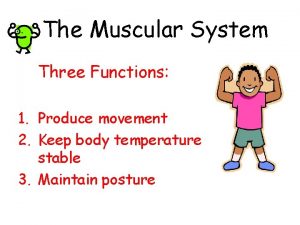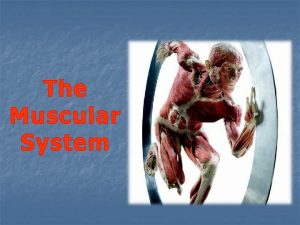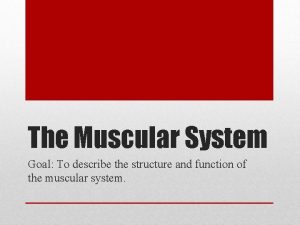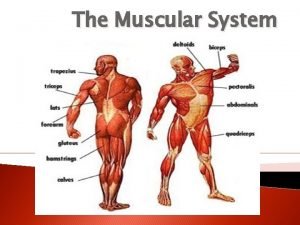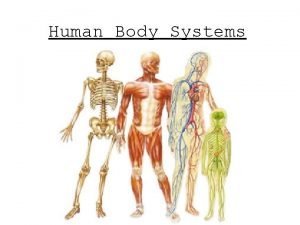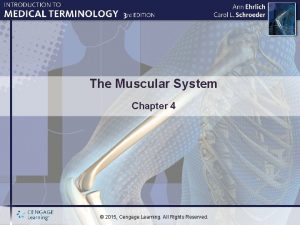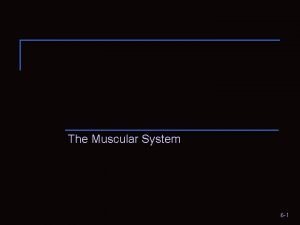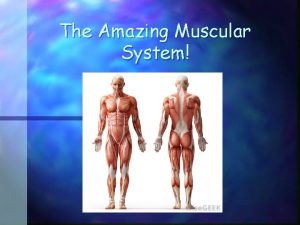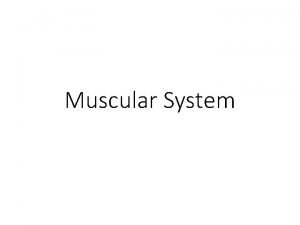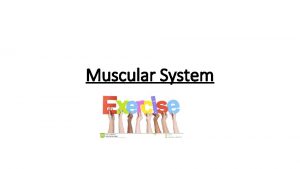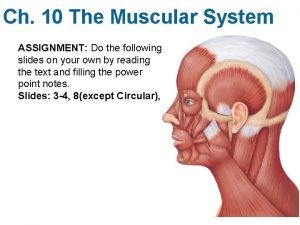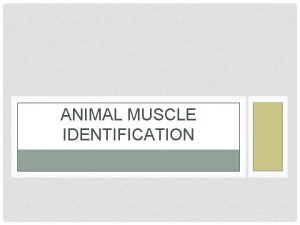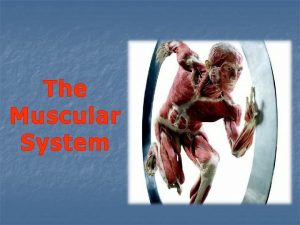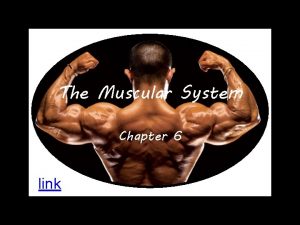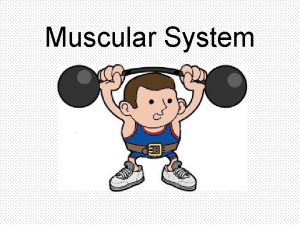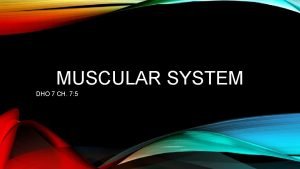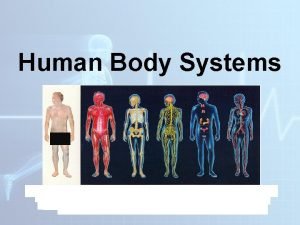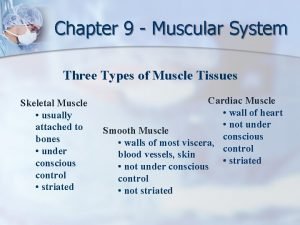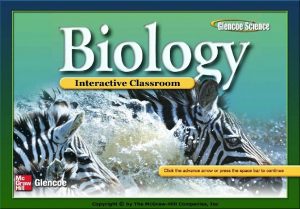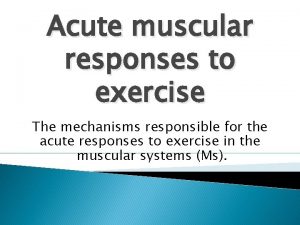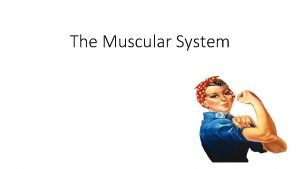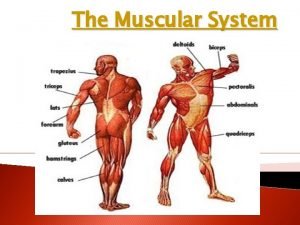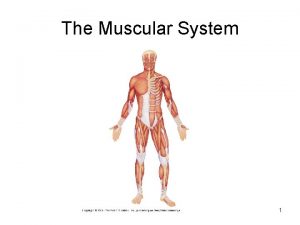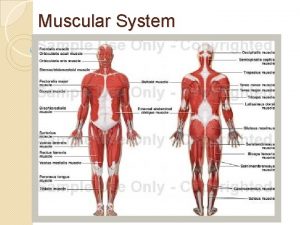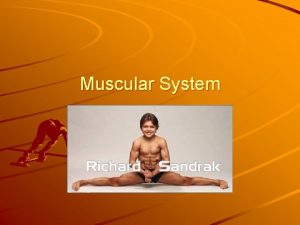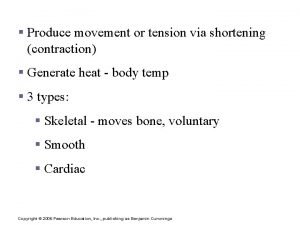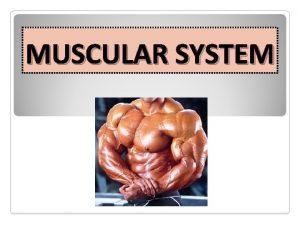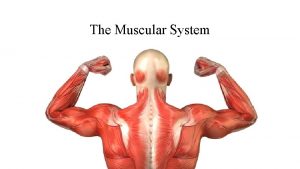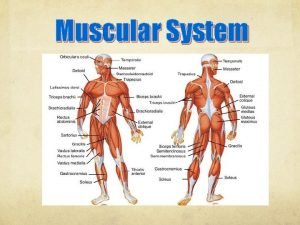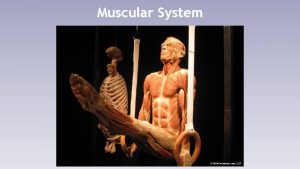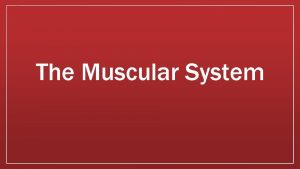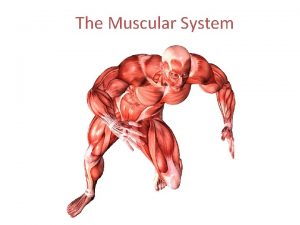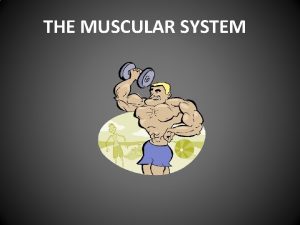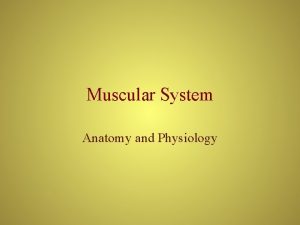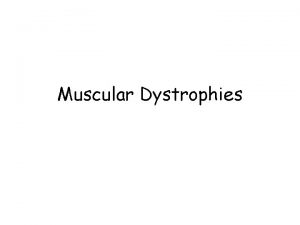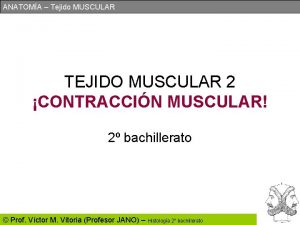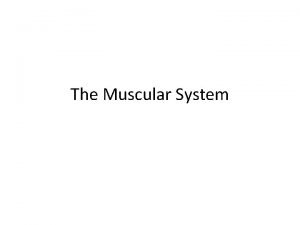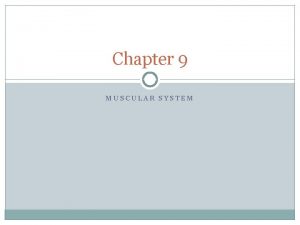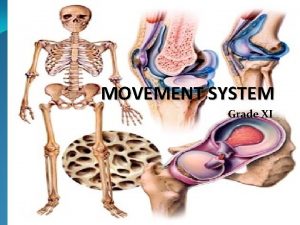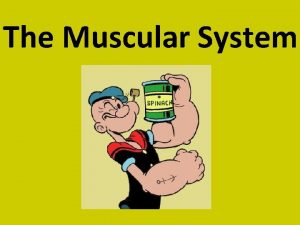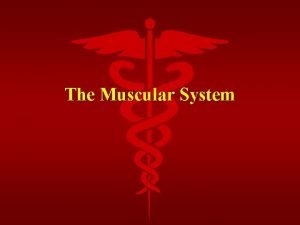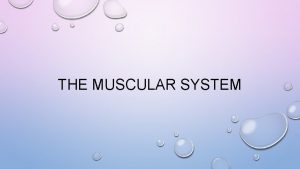Muscular System Muscular System Functions 1 produce movement

































- Slides: 33

Muscular System

Muscular System Functions: � 1. produce movement � 2. Maintain posture � 3. Stabilize joints � 4. Generate heat � 5. Move substances (fluid, food etc)

Properties of Muscles: �Excitability: capacity of muscle to respond to a stimulus �Contractility: ability of a muscle to shorten and generate pulling force �Elasticity: ability of muscle to recoil to original resting length after stretched

Muscular System · Muscles are responsible for all types of body movement – they contract or shorten and are the machine of the body · Three basic muscle types are found in the body · Skeletal muscle · Cardiac muscle · Smooth muscle

Skeletal Muscles: structure

· Muscle Coverings: Epimysium –tissue that covers the entire skeletal muscle. Separates the muscle from all other organs · Fascicle–A group of muscle fibers �Perimysium- surrounding a group a fascicle. Contains blood vessels and nerves. �Endomysium- surrounds individual muscle fiber. Also has blood vessels and nerves.

Muscle Coverings:

Head and Neck Muscles

Muscles of the cephalic area:

Trunk Muscles

Muscles of the Anterior Trunk area:

Muscles of the Posterior Trunk area: latissimus dorsi

Posterior of leg Muscles of the Posterior and Anterior Leg: Anterior of leg

Types of Ordinary Body Movements · Flexion – decreases angle of joint and brings two bones closer together · Extension- Increase the angle or extending something · Rotation- movement of a bone in longitudinal axis (back and forth), shaking head “no”

Types of Ordinary Body Movements · Abduction: Moving away from the body or anatomical position · Adduction: Moving towards the body or anatomical position. · Circumduction: moving in a circular motion

Types of Ordinary Body Movements · Flexion – decreases angle of joint and brings two bones closer together · Extension- Increase the angle or extending something · Rotation- movement of a bone in longitudinal axis (back and forth), shaking head “no”

Types of Ordinary Body Movements · Abduction: Moving away from the body or anatomical position · Adduction: Moving towards the body or anatomical position. · Circumduction: moving in a circular motion

Anatomy of Skeletal Muscles: · Cells are multinucleate

Anatomy of Skeletal Muscles: · Myofibril- The smallest unit · Bundles of myofilaments · Myofibrils are aligned to give distinct bands · I band = light band · A band = dark band

Anatomy of Skeletal Muscles: · Sarcomere- one segment on a myofibril (from Z disc to Z disc) · (these are what allow the muscle to contract and move)

Anatomy of Skeletal Muscles: �Components of a Sarcomere: · Thick filaments = myosin filaments · Has ATP ·(for energy to be broken down and used in order to move)

Anatomy of Skeletal Muscles: �Components of a Sarcomere: · Thin filaments = actin filaments

How skeletal muscles move or “slide” �Thin Actin slide past the thick Myosin so that the actin and myosin filaments overlap �In the relaxed state, thin and thick filaments overlap only slightly �In order for this process to start sodium must ender the cell (active transport) and the nervous tissue sends a signal to begin contraction

How skeletal muscles move or “slide” · Step 1: Activation by nerve causes Calcium to be released. · Step 2: This allows the myosin heads to attach to the actin. · Step 3: ATP is used and broken down in order to “pull” the myosin over the actin (contracting the muscle) · Step 3: Myosin heads then bind to the next site of the actin filament and get ready for a second contraction. This shortens the Z line and they over lap. · Step 4; They continue until the muscle contracts and the two over lap more and more until the H zone disappears. · Step 5: To release the contraction the Calcium is taken back into the muscle fibers which covers the location so myosin can’t bind. Now the muscle is relaxed · IF calcium doesn’t go back in the contraction is prolonged and called a charlie horse or Cramp!


How skeletal muscles move or “slide”

How skeletal muscles move or “slide” �Within a skeletal muscle, not all fibers may be stimulated during the same interval · Muscle force depends upon the number of fibers stimulated · More fibers contracting results in greater muscle tension · Muscles can continue to contract unless they run out of energy

Energy for Muscle contraction and fatigue · Muscles use stored ATP for energy · Only 4 -6 seconds worth of ATP is stored by muscles

Energy for Muscle contraction and fatigue · 1. After this initial time, other pathways must be utilized to produce ATP · Muscle cells contain creatine phosphate (CP) · CP regenerates new ATP · CP supplies only last 20 seconds

Energy for Muscle contraction and fatigue · 2. Glycolysis · Reaction that breaks down glucose with or without oxygen to make ATP · Without Oxygen glucose breaks into lactic acid which is what builds up and produces muscle fatigue.

Muscle Fatigue and Oxygen Debt · When a muscle is fatigued, it is unable to contract · The common reason for muscle fatigue is oxygen debt or lactic acid build up. · Oxygen is required to get rid of accumulated lactic acid

Disorders relating to the Muscular System �Muscular Dystrophy: inherited, muscle enlarge due to increased fat and connective tissue, but fibers degenerate and atrophy �Myasthemia Gravis: progressive weakness due to a shortage of acetylcholine receptors

For the test. . Muscular and Skeletal �For Skeletal – skeletal diagram �Bone formation �Joints – types, range of motion �For Muscular- the study guide except the following: � 6, 7, 12, 13, 14, 17, 18, 25
 Plyometrics disadvantages
Plyometrics disadvantages Three functions of muscular system
Three functions of muscular system Prime mover of knee flexion
Prime mover of knee flexion Function of muscles
Function of muscles Muscular syst
Muscular syst 3 function of the muscular system
3 function of the muscular system Control tower light signals
Control tower light signals Axial
Axial Absolute value piecewise function
Absolute value piecewise function How to solve evaluating functions
How to solve evaluating functions Evaluating functions and operations on functions
Evaluating functions and operations on functions Chapter 4 the muscular system learning exercises answer key
Chapter 4 the muscular system learning exercises answer key Chapter 6 the muscular system figure 6-9
Chapter 6 the muscular system figure 6-9 Amazing facts about the muscular system
Amazing facts about the muscular system Muscular word root
Muscular word root Muscular system label
Muscular system label Chapter 6 the muscular system
Chapter 6 the muscular system Muscular system head and neck
Muscular system head and neck Brachiocephalicus
Brachiocephalicus Navigating the body muscular system #3
Navigating the body muscular system #3 Whats the function of the muscular system
Whats the function of the muscular system Chapter 6 the muscular system figure 6-9
Chapter 6 the muscular system figure 6-9 Whats muscular system
Whats muscular system Chapter 7:5 muscular system
Chapter 7:5 muscular system Chapter 9 muscular system
Chapter 9 muscular system Structures of the muscular system
Structures of the muscular system Site:slidetodoc.com
Site:slidetodoc.com Chapter 32 section 3 the muscular system answer key
Chapter 32 section 3 the muscular system answer key Muscular system response to exercise
Muscular system response to exercise How your muscular system works
How your muscular system works Myo muscle
Myo muscle Chapter 6 the muscular system figure 6-9
Chapter 6 the muscular system figure 6-9 Muscle levels
Muscle levels Superficial muscular system
Superficial muscular system

